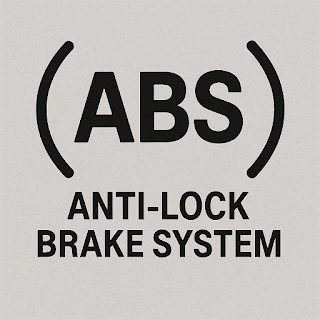ABS (Anti-Lock Brake System)
ABS helps the driver maintain steering control while braking hard. Wheel-speed sensors designed to detect wheel lockup can send a signal to a control unit that in turn can modulate the brake-line pressure to that wheel.
An anti-lock brake system, ABS, is a system which is designed to prevent you from “locking” up your brakes, or applying so much pressure to your brakes that the axle and your wheels themselves stop turning completely. When your wheels stop turning but your car is still moving too fast, you start to skid, and skidding causes you to lose total control over your vehicle, which is a dangerous prospect when traveling at high speeds.an anti-lock brake system doesn’t actually stop your car faster than a traditional brake system—in fact, it adds a small amount of distance. However, it does enable you to have control over your car, providing you the ability to possibly steer out of the way of an accident and avoid serious injury. Likewise, it increases the lifespan of your tires, your brake pads, your brake calipers, your wheels, and just about everything else on your car which braking can influence.
Traction control is a system designed to keep all four wheels on the ground rolling smoothly. If it detects that one wheel starts to spin irregularly, it will cut off power from your engine until it establishes stable traction again. This is designed to prevent you from skidding out of control by accidentally applying too much power. However, because both your ABS and traction control share a control module and self-diagnostic system, one can sometimes interfere with another. Sometimes an issue with your traction control light can cause your ABS light to come on as well, but other times the issue is with your ABS system. You’ll need to have your vehicle professionally diagnosed to figure out exactly what’s going on.
The anti-lock braking system (ABS) is now a standard safety system in all cars. Its purpose is to keep the driver safe by preventing the wheels from locking when you use the brakes. You are able to keep control over the steering and your vehicle won’t skid as a result of the wheels locking up.
There is a warning light on the dashboard which will come on if there is any problem with the ABS. This is a light that needs to be taken seriously because it is an early warning sign that your ABS needs to be inspected.
There is also a brake system light that will come on if there is an issue with the braking system. It lets you know that it is time to take your vehicle to our specialists to check over your car’s brakes and make any adjustments needed.
TWO THINGS TO KNOW ABOUT ABS SAFETY -
1) On most vehicles the ABS system does a self-test every time you turn on the car. Once you start your vehicle, the light will briefly come on, and if the computer finds a problem, the light will stay on. If you notice the light flash immediately after starting the vehicle, then it's just a self-check.
2) The brake pedal will act differently when ABS is engaged. That pulsating you notice isn't caused by the adrenaline that you feel in a dangerous situation. It's the ABS system trying to make sure you the mechanical system does not lock up. Once you feel this pulsating, don't release the brake. That would be a signal to the brakes that the danger is over. Instead keep your foot on the brake pedal and let the ABS system do its work.
The sensor is located on the car's transmission and this is why it is sometimes called the transmission speed sensor. It sends information to your speedometer and your engine’s computer to tell the transmission when to shift.






No comments:
Post a Comment